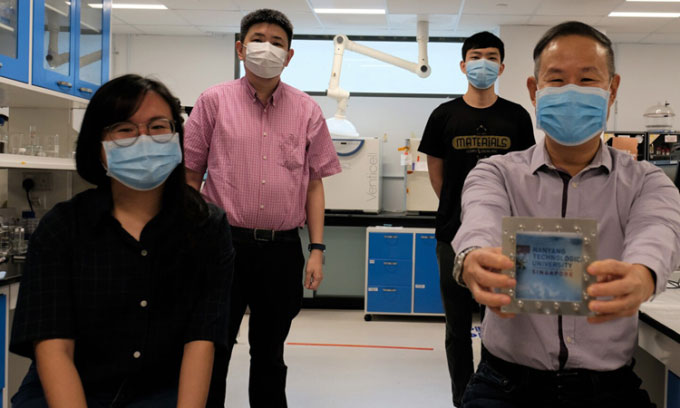Scientists Develop New Material for Window Coatings to Control Heat Transmission Throughout the Year
When sunlight streams through windows, indoor temperatures can rise to levels that necessitate the use of energy-consuming air conditioning systems. A team of experts from Nanyang Technological University (Singapore) and the Hebrew University of Jerusalem (Israel) has developed a new material that allows windows to switch states to block heat while maintaining high transparency, as reported by New Atlas on November 9. The new research has been published in the journal ACS Omega.

Research team at Nanyang Technological University with a window sample incorporating the new material. (Photo: NTU Singapore).
Some current constructions use electrochromic windows that can change color based on demand. However, when the glass darkens, it becomes difficult for users to see through. Additionally, while they may block some parts of the visible spectrum of sunlight, they do not necessarily block the infrared spectrum, which generates heat.
The new material addresses this issue. It consists of a cost-effective mixture of titanium dioxide, tungsten trioxide, neodymium-niobium, and tin oxide. This material can be applied as a coating on regular windows and connected to an electrical circuit.
When users want to allow more heat from sunlight, such as in winter, they simply deactivate the material. This allows all infrared radiation from sunlight to pass through. Conversely, in warmer months, the material is activated. According to the research team’s simulations, it can block up to 70% of incoming infrared radiation while still allowing up to 90% of visible sunlight to pass through.
Currently, electrochromic windows typically begin to lose effectiveness after 3 to 5 years of use. However, repeated on-off testing has shown that the new material is significantly more durable. Furthermore, windows integrated with this material can also have an additional electrically activated film created by the same research team. This film uses carbon nanoparticles to conduct or block heat from the external environment.
“With the ability to control both infrared radiation from the sun and heat conduction through the window, we expect this technology to be particularly useful in temperate climates. Residents in buildings can use it to adjust heat levels according to seasonal needs while still enjoying most of the outside view,” shared Dr. Ronn Goei from Nanyang Technological University.

















































